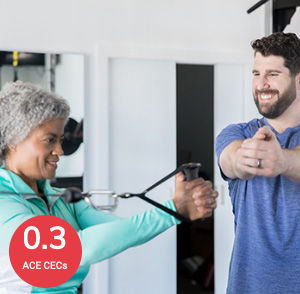
Chronic disease is a growing public health concern, but one that can be managed, or even reversed with the use of thoughtful, intentional and strategic solutions. Medical professionals are not the only members of the healthcare continuum equipped to combat this emerging concern; certified health coaches are critical players who possess a unique set of coaching and motivational skills to assist clients in managing and overcoming chronic conditions. Supporting clients who deal with chronic conditions, however, requires certain considerations and self-awareness. This article examines what you can do to coach your clients toward a less limiting lifestyle.
Chronic Disease Facts
The first step in addressing issues these clients face is developing a deeper understanding of how widespread the presence of chronic disease is. An estimated 60% of adults in the United States have at least one chronic disease and four in 10 adults have two or more.
We already know heart disease, cancer, stroke, chronic lung disease, Alzheimer’s disease, chronic kidney disease and diabetes are primary causes of death, disability and dysfunction. Additionally, the costs of managing and treating these conditions are extreme and considered primary contributors to the nation’s $3.5 trillion annual healthcare costs. Chronic disease presence is not just common; it’s becoming normal. And that is terrifying. As health coaches, we don’t just have an opportunity to ignite change in our clients; we have a professional responsibility to do so in a meaningful way such that the landscape of chronic disease is forever transformed.
Defining Chronic Disease and Risk Factors
A chronic disease, otherwise known as a lifestyle disease, hypokinetic disease and/or noncommunicable disease, is described as a condition that lasts one year or longer and requires specific ongoing medical treatment and intervention. These conditions commonly limit activities of daily living and include heart disease, stroke, cancer and diabetes. Other conditions considered chronic that you may encounter include asthma and chronic obstructive pulmonary disease (COPD), mental illness, arthritis and obesity.
While the incidence of chronic disease is growing and the outlook is not as promising as we would hope, the major risk factors associated with the progression of these conditions are modifiable and highly responsive to behavior-change interventions. The most common major lifestyle risk factors include excessive alcohol use, tobacco use, poor nutritional habits and a lack of physical activity. This is where thoughtful intervention and mindful coaching can help slow and, potentially, reverse the trend.
A Closer Look at Prevention and Existing Trends
According to research published by the Centers for Disease Control and Prevention (CDC), the “five key health-related behaviors for chronic disease prevention are never smoking, getting regular physical activity, consuming no alcohol or only moderate amounts, maintaining a normal body weight and obtaining daily sufficient sleep.”
On the surface, these behaviors seem reasonable, but the lifestyle of many Americans is such that these five behaviors are not highly prioritized. The aforementioned study examined these five key behaviors of 395,343 respondents, aged 21 or older, and revealed the following:
- 81.6% were current nonsmokers
- 63.9% obtained seven hours or more sleep per day
- 63.1% reported moderate or no alcohol consumption
- 50.4% met physical-activity recommendations
- 32.5% had a normal body mass index (BMI)
- 1.4% engaged in none of the five behaviors
- 8.4% engaged in one behavior
- 24.3% engaged in two behaviors
- 35.4% engaged in three behaviors
- 24.3% engaged in four behaviors
- 6.3% reported engaging in all five behaviors
Interestingly, the highest prevalence of respondents engaging in four or five behaviors occurred in the populations of the Pacific and Rocky Mountain states. In contrast, the lowest prevalence was among participants who lived in the south and along the Ohio River.
The findings of this study suggest that while adults are participating in some positive and supportive health behaviors aimed at mitigating the development and effects of chronic disease, those behavior patterns are not consistent across the U.S. This means there is a high degree of geographical variation in the health behaviors of Americans.
Why is this important? Health coaches (and other members of the healthcare team) must consider the significance of these findings and focus their efforts on developing behavior-change interventions that are collaborative and comprehensive in hopes of reducing the observed variability noted in this research study. Creating change will require both time and collaboration, but it is possible.
Lessons From the Field
Lee Jordan is an educator and national presenter, and Chris Gagliardi is the Scientific Education Content Manager for the American Council on Exercise. Both are also ACE Certified Health Coaches and have shared some of the interesting lessons and unique challenges they encountered when first working with clients with chronic disease. The lessons they offer provide unique insight that all health coaches—seasoned and novice alike—can apply to their everyday interactions with clients.
Remain Mindful of Foundational Principles
The overall approach we take with clients should not be altered because a client has a chronic disease. Although each coaching session with each client is unique, the philosophy remains unchanged. Gagliardi urges health coaches to keep the consistent application of health coaching principles and goals at the forefront of their attention.
“The art of coaching comes alive when you apply what you learn with different people and within different scenarios,” explains Gagliardi. “Every coaching session may look and sound different but at the foundational level, we are using these guiding principles to empower clients to make the changes they want.”
Say No to the Righting Reflex
The lesson Jordan offers isn’t related directly to the client or the disease; rather, he acknowledges how challenging it can be to battle the natural impulse we have to “tell” clients what to do instead of partnering with them to discover their own skills and abilities to make positive change.
Ultimately, health coaches want nothing more for clients than for each of them to achieve meaningful change. However, the goal of coaching isn’t to tell or direct but to guide and inspire. During the coaching process, we sometimes need to stop ourselves from engaging with the naturally present “righting reflex,” which causes a coach to want to say: “Wait! Don’t do that. Do this instead!”
When we are coaching a client with a chronic disease or set of diseases, explains Jordan, health coaches may find a great challenge in coaching clients through contrasting behaviors. It may be easy for you as the coach to see the difference between behaviors that can lead to health improvement and those that may lead to disease, but for the client this juxtaposition may not be as clear. “The juxtaposition of our client’s perception of impending ‘doom’ contrasted with life-changing health enhancement through engaging in low-risk behaviors is where health coaches find a great challenge,” says Jordan.
“When our coaching is overcome by the righting reflex, sparking our caring emotions to ‘save’ the client, we abandon the evidence-based coach approach and embrace the belief that we must convince, confront and persuade the client to do what they must to save their life,” Jordan says.
The “righting reflex” is counterproductive to change. If a health coach engages in a more directive/telling approach, research suggests the client will ultimately and actively resist making the changes they desire.
6 Traps That Commonly Occur in the Engaging Process
Miller and Rollnick, coauthors of Motivational Interviewing: Helping People Change, discuss the following “traps,” of which health coaches should be aware during the engaging process with a client:
- Assessment trap: The coach spends time asking the client a series of questions. This is one-directional and generally not that useful to the client. It shuts down the process of engaging from the start.
- Expert trap: Portraying oneself as the expert who has the answer of what the client should do does not help the client take ownership of the change. Activation of the righting reflex would fit here.
- Premature focus trap: This occurs when the coach tries to set the agenda and home in on a specific needed behavioral change too quickly. It is important for the conversation to start with the client’s concerns, not those of the coach.
- Labeling trap: The coach “names” the problem—e.g., smoking, obesity, or diabetes—that needs to be fixed. This can trigger in the client a feeling of alienation and stigma.
- Blaming trap: The client may feel guilty or feel that the coach will blame him or her for the problem. It is important from the start for the coach to disarm the client and acknowledge that the coach is not concerned with who is to blame for the problem but rather understanding better what the problem is and how the client may best address it.
- Chat trap: Spending too much time on “small talk” rather than moving the agenda forward with a sharp focus on the client’s concerns and the goals of the coaching experience.
Consistently applying the foundational principles of health coaching, regardless of a client’s health status, and fighting the natural “righting reflex” are challenges many health coaches face. However, there are other challenges that require our awareness.
Be Aware of Your Scope of Practice
Like all health and exercise professionals, certified health coaches have a defined scope of practice (determined by state policies and regulations and credentials) and professional role. According to the National Board for Health and Wellness Coaching, certified health and wellness coaches:
Partner with clients seeking to enhance their well-being through self-directed, lasting changes, aligned with their values. In the course of their work, health and wellness coaches display an unconditional positive regard for their clients and a belief in their capacity for change, honoring the fact that each client is an expert on their own life, while ensuring that all interactions are respectful and non-judgmental.
When it comes to scope of practice, the health coach is expected to:
- Apply effective communication skills to help a client increase internal motivation and ownership to make a health-behavior change
- Support clients in developing SMART (specific, measurable, attainable, relevant and time-bound) goals to monitor success and motivate ongoing behavior change
- Empower clients to develop and leverage their strengths
In other words, as a certified health coach, you can provide strategic and thoughtful guidance as it relates to physical activity, nutrition and behavior change. But you should never “go it alone”; rather, you need to rely on a client’s primary care provider and other healthcare professionals to offer comprehensive client support.
Dealing With Client Frustration
Dealing with a chronic disease is frustrating for clients. It’s a slow change process and it is easy for a client to become discouraged early on. If a client is newly diagnosed, they may need to process the diagnosis and move through the stages of grief as they come to accept their new reality. This may cause psychological and emotional distress. As a health coach, you must be sensitive to a client’s frustration and allow ample time for a client to share their feelings in a safe and nonjudgmental environment.
Educate Yourself
While a health coach isn’t a medical professional responsible for treating or managing a client’s chronic condition, the health coach is responsible for developing a solid understanding of chronic conditions. This requires additional continuing education, research and study. Of course, this does not mean the health coach needs to become the expert on every possible chronic condition.
“While having knowledge on chronic conditions is important,” says Gagliardi, “if you are too focused on trying to remember every little detail about every condition, it can be challenging to stay focused on the client because your mind begins to search for buried information.”
Gagliardi encourages health coaches to ask themselves one thoughtful and reflective question: “How important is it for me to remember this right now?” If you find that the information is not valuable or critical to coaching change in that moment, make a note to follow up on the topic once the session concludes, but don’t let it become the focus of the session.
As a health coach, you can support your knowledge of chronic conditions by seeking answers to your questions without overburdening yourself or perceiving that a client will expect you to be an expert on every disease or condition. That is the responsibility of a primary care provider.
Encourage Clients to Consistently Monitor Disease Parameters
A client with a chronic condition needs to consistently monitor their health. For example, a client with diabetes must remain mindful of blood sugar levels, while a client with a history of blood pressure concerns must comply with prescription medications and follow specific recommendations their physician provides. This takes extra effort on the part of the client (especially if the client is new to the diagnosis). As a health coach, you play a pivotal role in checking in with a client and encouraging daily monitoring efforts. Any changes in a client’s status should be noted and communicated to the healthcare team.
Three Ways to Support Clients With Chronic Disease
1. Take a Team Approach
Typically, a client with a chronic condition will already be under the care of a physician or other medical professional. It’s critical that you develop relationships with each member of the client’s team to provide the best service and most comprehensive experience. “Taking a team approach,” explains Gagliardi, “leads to the best care for clients and allows you as the coach to focus on what you do best—collaborating with and empowering clients to change behavior.”
ACE Certified Professionals, click on the Bonus Tool at the top of this page to access a sample medical release form to use with clients. This form explains physical-activity limitations and/or guidelines as outlined by the client’s physician.
2.Practice Self-awareness
Like our clients, we are all human and subject to personal biases and habits. To be an effective coach and offer your clients a transformative experience, you must be mindful of your “blind spots” so that they do not interfere with your coaching efforts. Take time to invest in self-reflection and seek feedback from clients and others in your professional network. To be effective, you have to be willing to grow.
“As health coaches seeking to serve clients with chronic diseases,” says Jordan, “it is all the more important that we invest in self-awareness and a mindful intentional approach to ensure we stay free of the righting reflex.”
3. Keep it Simple and Stay in the Moment
While behavior change can be a complex process, as a health coach your focus should be on helping a client make lasting and meaningful lifestyle changes and develop self-management techniques.
Gagliardi reminds health coaches to rely on their professional philosophy and use the ACE ABC ApproachTM (a component of the ACE Mover MethodTM) to keep the process simple and collaborative. This means asking open-ended questions, breaking down barriers and collaborating.
“Coaching can be as complex as you want it to be,” explains Gagliardi. “If you find that you are like me and often complicate the process in the moment, it may be a good idea to take a step back and think about why you are doing what you are doing. If you are thinking too much about what to do next, it is easy to lose sight of what is taking place right now.”
Perhaps the most important aspect to coaching any client, regardless of the presence or absence of disease, is to do so with unconditional positive regard. Be empathetic and patient and respect that the journey of change is as unique as your clients’ fingerprints. It’s a journey only your client can understand and direct; it’s a highly personal decision and experience.
“We can support the client’s decision and apply strategies,” says Gagliardi, “while never losing site of the acceptance we have for each client.”





 by
by 





